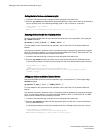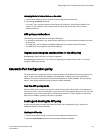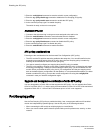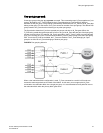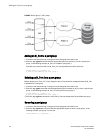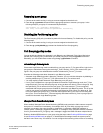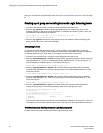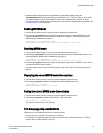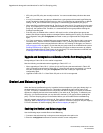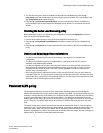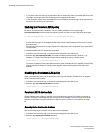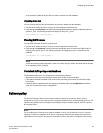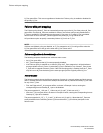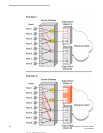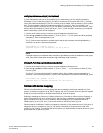• APC policy and PG policy are mutually exclusive. You cannot enable these policies at the same
time.
• If an N_Port is added to a port group or deleted from a port group and Automatic Login Balancing
mode is enabled or disabled for the port group, the N_Port maintains its original failover or failback
setting. If an N_Port is deleted from a port group, it automatically gets added to port group 0.
• When specifying a preferred secondary N_Port for a port group, the N_Port must be from the same
group. If you specify an N_Port as a preferred secondary N_Port and it already belongs to another
port group, the operation fails. Therefore, it is recommended to form groups before defining the
preferred secondary path.
• If the PG policy is disabled while a switch in AG mode is online, all the defined port groups are
deleted, but the port mapping remains unchanged. Before disabling the PG policy, you should save
the configuration using the configUpload command in case you might need this configuration
again.
• If N_Ports connected to unrelated fabrics are grouped together, N_Port failover within a port group
can cause the F_Ports to connect to a different fabric. The F_Ports may lose connectivity to the
targets to which they were connected before the failover, thus causing I/O disruption, as shown in
How port groups work on page 57. Ensure that the port group mode is set to MFNM mode (refer to
Enabling MFNM mode on page 61). This monitors the port group to detect connection to multiple
fabrics and disables failover of the N-ports in the port group. For more information on MFNM, refer
to Managed Fabric Name Monitoring mode on page 59.
Upgrade and downgrade considerations for the Port Grouping policy
Downgrading to Fabric OS v6.4.0 or earlier is supported.
Note the following considerations when upgrading to Fabric OS 7.1.0:
• When upgrading to Fabric OS v7.1.0 from v6.4.0, the PG policy that was enforced in Fabric OS
v6.4.0 continues to be enforced in Fabric OS v7.1.0 and the port groups are retained. You should
save the configuration file using the configUpload command in case you might need this
configuration again.
• Upgrade to Fabric OS v7.1.0 from Fabric OS prior to v6.4.0 is not supported.
Device Load Balancing policy
When the Device Load Balancing policy is enabled, devices mapped to a port group always log in to
the least-loaded N_Port in that port group. This helps to distribute the login load on each of the
N_Ports. This policy is intended for use in conjunction with device mapping. It provides an automatic
approach to mapping devices to the least-loaded N_Port within an N_Port group. To effectively use
this policy, it is recommended that you map devices to desired N_Port groups before enabling this
policy. The Port Grouping policy must be enabled before you can enable Device Load Balancing.
Manually created mappings from devices to N_Ports take precedence over automatically created
mappings. Refer to Mapping priority on page 45 for details on connection priority for AG port mapping.
For more information on device mapping, refer to Device mapping on page 37.
Enabling the Device Load Balancing policy
Use the following steps to enable Device Load Balancing.
1. Connect to the switch and log in using an account assigned to the admin role.
2. Enter the configUpload command to save the switch’s current configuration.
Upgrade and downgrade considerations for the Port Grouping policy
62 Access Gateway Administrator's Guide
53-1003126-02



